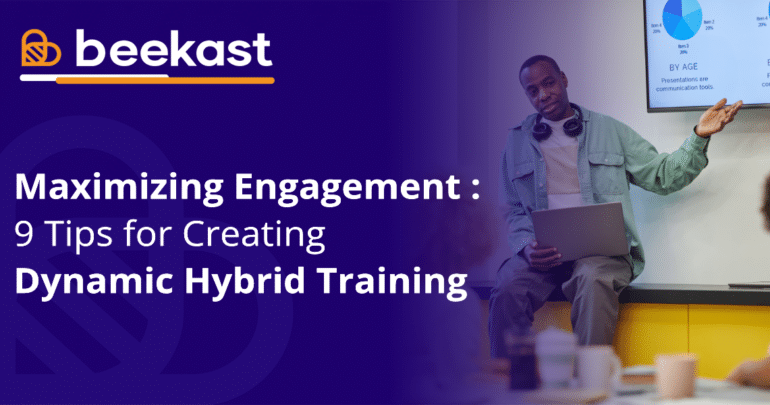The popularity of hybrid mode is soaring globally, and its potential in training programs is equally promising. The introduction of an asynchronous hybrid training program eliminates the need for trainers and participants to be present simultaneously.
Offering such training sessions to your employees provides them with the flexibility to learn at their own pace without any time restrictions. Furthermore, the incorporation of digital tools that facilitate interactive activities not only enhances the accessibility and appeal of these professional training programs but also simplifies the process of evaluating the learners.
How to Create Dynamic Hybrid Training Sessions
Managing and energizing hybrid training programs that involve both in-person and online participants can be challenging. Therefore, leveraging new technologies to engage your participants and motivate them to participate in these programs is essential.
Here are 9 tips to make your hybrid training programs more dynamic:
1. Vary the Training Formats
Opt for mixed training formats to offer your learners a dynamic and interactive hybrid training program. For example, blended learning allows you to vary the training formats and the way the courses are delivered: synchronous or asynchronous, in-person, hybrid, or remote.
Blended learning can be highly appealing to learners, particularly if you incorporate in-person sessions to reinforce the skills acquired online and make the program accessible regardless of space and time constraints.
To create dynamic hybrid training programs, consider leveraging collaborative tools like Beekast: a collaborative platform that enables trainers and participants to interact and collaborate seamlessly, fostering engagement and improving learning outcomes.
2. Use a Variety of Pedagogical Supports
The training program should not only contain text, but it is always advisable to vary the media to prevent your participants from getting bored. With Beekast, you can integrate various content formats such as PDF or PPT or directly embed your Prezi, Genially, or Google Slide presentations.
With Beekast, you can easily create customized slides and incorporate multimedia elements to make your hybrid training programs more engaging and interactive. The image bank feature allows you to choose from a wide range of images that are directly integrated into the platform. In addition, Beekast supports video content in MP4 format, as well as videos from popular sites like YouTube, Dailymotion, and Vimeo.
Related Reading:
5 Top Alternatives to Google Slides
3. Create a Positive Learning Environment
This allows participants to feel more motivated and engaged in the training process. Thus, they are more likely to participate actively in training activities.
A positive environment encourages collaboration among learners and between learners and the trainer. Learners can share ideas and experiences to understand better the concepts and theories being discussed.
4. Engage Your Participants From the Start
Engaging your participants from the outset is a key strategy for maintaining dynamism and sustained attention throughout your training program.
To do this, start a training session with an icebreaker. For example, survey your learners using the “Film Critic” template, where you ask your participants to pick the movie that best represents their own current mood or state of mind.
5. Encourage Learner Participation
Encouraging participation and facilitating the sharing of experiences and perspectives among learners can enrich the training experience and lead to a more comprehensive understanding of the subject matter.
To encourage learner participation in your training, use the “MCQ” activity, where participants will answer different questions and discuss the possible answers together.
This activity also helps to strengthen learner engagement and encourage social interaction among them, which can help to make hybrid training more dynamic.
6. Integrate Moments of Reflection
A valuable strategy for consolidating knowledge and promoting deeper learning among participants. By providing learners with opportunities to reflect on what they have learned, trainers can help them integrate new information into their overall understanding of the subject matter.
One effective way to facilitate reflection is by using interactive templates like Brainwriting. This activity allows learners to express themselves freely and share their thoughts and insights with the group, fostering engagement and promoting peer-to-peer learning.
7. Encourage Learner Autonomy
Allow each learner to work at their own pace. This will improve the learning experience. With Beekast, you can create asynchronous sessions where the participant can control the pace of their own learning.
Furthermore, by encouraging autonomy, you save a significant amount of time, and you empower your learners, which helps them feel more engaged and invested in their learning and, thus more effective.
8. Challenge Your Participants
Challenges can be a highly effective way to motivate participants and promote engagement in the learning process.
Moreover, challenges can accelerate the development of new skills among participants by providing a structured and engaging way to apply their learning in practice. With Beekast, you can easily create teams and assign individual and collective points, making it simple to track progress and reward achievement. The Challenge activity is a powerful tool for testing your team’s knowledge and promoting healthy competition, encouraging learners to stay engaged and focused throughout the training program.
At the end of the training, you can also display the leaderboard where you can see the individual and team rankings, which motivates your teams to participate and be attentive during the session.
9. Regularly Ask For Feedback From Your Participants
Regularly collecting feedback from learners is a critical component of effective training, as it allows trainers to understand participants’ expectations better and adjust their approach as needed.
The Beekast ROTI template is a powerful tool for gathering feedback from participants on their training experience. By asking learners to rate the relevance, organization, and impact of the training, trainers can gain valuable insights into what worked well and what needs improvement.
By applying the tips outlined above, trainers can not only promote the development of their teams but also foster greater autonomy, address skills gaps, and remove any barriers to learning.
By keeping training sessions engaging and interactive, colleagues are less likely to become disengaged or bored and more likely to be motivated to follow along and learn. This can help to facilitate learning, build skills, and foster a culture of continuous improvement within the organization.

